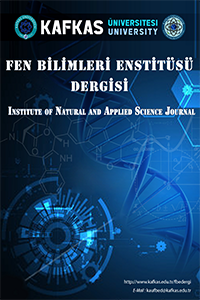Çelik Malzeme Yüzeyinde Farklı Lazer Güçlerinin Etkisinin İncelenmesi
Lazer işleme, Çelik, CO2 Lazer, Yüzey Tekstüre Etme, Lazer Aşındırma
Investigation of the Effects of the Different Laser Powers on the Steel Surface
Laser machining, Steel, CO2 Laser, Surface Texturing, Laser Ablation.,
___
- Aboulkhair N. T., Maskery I, Tuck C, Ashcroft I.,Everitt N. M., (2016) The microstructure and mechanical properties of selectively laser melted AlSi10Mg: The effect of a conventional T6-like heat treatment, Materials Science&Engineering, A667139-146.
- Adams R. O., (1983) A review of the stainless steel surface,: Journal of Vacuum Science & Technology A 1, 12. Altenberger I., Scholtes B., Martin U., Oettel H. (1999). Cyclic deformation and near surface microstructures of shot peened or deep rolled austenitic stainless steel AISI 304, Material Science and Engineering Technology. (264). (1-16).
- Ceau G.,Popovici V., Croitoru S., (2010). Researches About the Temperature of The Cutting Edge in Turning of Unalloyed Steel, Scientific Bulletin-University Politehnica of Bucharest, (72) 97-111.
- Choudhary S.K. and Ganguly S., (2007), Morphology and Segregation in Continuously Cast High Carbon Steel Billets, ISIJ International, Vol. 47 No. 12, pp. 1759–1766
- Ghaini F. M., Hamedi M.J., Torkamany M.J., Sabbaghzadeh J., (2007) Weld metal microstructural characteristics in pulsed Nd: YAG laser welding, Scripta Materialia, (56) 955-958.
- Gardner L., (2005), The use of stainless steel in structures, Progress in Structural Engineering and Materials, (7) 45–55.
- Morozov D Yu.., Chevskaya O. N., Filippov G. A., and Muratov A. N. (2007). Fire-Resistant Structural Steels”, Metallurgist, (5)1, 7–8,.
- Musfirah A.H, Jaharah A.G., (2012), Magnesium and Aluminum Alloys in Automotive Industry, Journal of Applied Sciences Research, 8(9): 4865-4875
- Narasimharaju S. R., Wenhan Zeng W., See T. L., Zhu Z.,Scott P.,Jiang X., Lou S., (2022) A comprehensive review on laser powder bed fusion of steels: Processing, microstructure, defects and control methods, mechanical properties, current challenges and future trends, Journal of Manufacturing Processes, 75, 375-414.
- Rogers C. C., (1979) Adiabatic Plastic deformation, Ann. Rev. Mater. Sci. 9: 283-311
- Shi X.,, Gu D., Li Y., Dai D., Ge Q., Sun Y., Chen H., (2021) Thermal behavior and fluid dynamics within molten pool during laser inside additive manufacturing of 316L stainless steel coating on inner surface of steel tube, Optics and Laser Technology, (138) 106917.
- Tabernero V. M. A., Kumar A., Petrov R. H., Monclus M. A., Aldereguia J.M. M., Sabirov I., (2020) The sensitivity of the microstructure and properties to the peak temperature in an ultrafast heat treated low carbon-steel, (776) 1-35.
- Tabernero, I., Lamikiz A., Martínez S., Ukar E., López de Lacalle L.N. (2012) Modelling of energy attenuation due to powder flow-laser beam interaction during laser cladding process, Journal of Materials Processing Technology, (212) 516-522.
- Tung C. S. And McMillan M. L., (2004), Automotive tribology overview of current advances and challenges for the future, Tribology International 37 517–536
- Zarei O., Fesanghary M., Farshi B., Jalili Saffar R., Razfar M.R. (2009). Optimization of multi-pass face-milling via harmony search algorithm, Journal of Material Processing Technology, (209) 2386-2392.
- ISSN: 2587-2389
- Yayın Aralığı: Yılda 2 Sayı
- Başlangıç: 2008
- Yayıncı: Kafkas Üniversitesi
Katı Yakıtların Şişme Özelliklerinin İncelenmesi ve Sıvılaştırılması
Ahmet Turan TEKEŞ, Aslıhan Aycan TANRIVERDİ, Ahmet Muammer CANEL
Çelik Malzeme Yüzeyinde Farklı Lazer Güçlerinin Etkisinin İncelenmesi
İlköğretim Matematik Öğretmeni Adaylarının Bakış Açısından “Örnekler”
Ortaokul Öğrencilerinin Sosyal Ağ Kullanım Analizi: Kars İli Örneği
